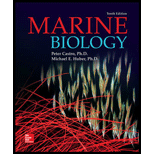
Plate tectonics works today in the same way as in the past. Can you project the future positions of the continents by looking at a map of their present positions and the positions of the mid-ocean ridges (see Fig. 2.5)? Which oceans are growing and which are shrinking? Where will new oceans form?
FIGURE 2.5 The major features of the sea floor. Compare this map with Figure 2.6.

To predict: The future positions of the continents by looking at the map of their present positions and the positions of the mid-ocean ridges.
Introduction: The continents in the earth’s crust or plates that float on the mantle portion of the Earth are called plate tectonics. The movement of plate causes formation of the mountain and continents over a millions of years that result in the geographical changes of the Earth.
Explanation of Solution
Plate tectonics are the lithospheric plates composed of continental and oceanic lithosphere. Refer to Fig. 2.5, “The major features of the sea floor”, in the text book. The future positions of the continents are given in Table 1.
Tabular representation: The following table shows the future positions of the continents.
Table 1: The future positions of the continents
| Continents | Future positions |
| North and South America | Farther west toward the Pacific Ocean |
| Europe and Asia | Farther southeast |
| Australia | Farther northeast |
| Africa | Farther east |
To determine: The oceans that are growing and shrinking.
Introduction: The continents in the earth’s crust or plates that float on the mantle portion of the Earth are called plate tectonics. The movement of plate causes formation of the mountain and continents over a millions of years, which result in the geographical changes of the Earth.
Explanation of Solution
Plate tectonics are the lithospheric plates composed of continental and oceanic lithosphere. Refer to Fig. 2.5, “The major features of the sea floor”, in the text book. The shrinking ocean is Pacific Ocean (expected to be narrower) and the growing ocean is Atlantic Ocean (expected to be wider).
To determine: Where will the new oceans form.
Introduction: The continents in the earth’s crust or plates that float on the mantle portion of the Earth are called Plate tectonics. The movement of plate causes formation of the mountain and continents over a millions of years, which result in the geographical changes of the Earth.
Explanation of Solution
Refer to Fig. 2.5, “The major features of the sea floor”, in the text book. The edges of several plates are formed by the mid-ocean ridges. At this point, the lithospheric plates move apart to form the new oceanic lithosphere (new sea floor). If the plate contains a block of continental crust, the plate moves away from the ridge, and the continent is carried along with the plate.
Want to see more full solutions like this?
Chapter 2 Solutions
Marine Biology (Botany, Zoology, Ecology and Evolution)
- Molecular Biology Question You are working to characterize a novel protein in mice. Analysis shows that high levels of the primary transcript that codes for this protein are found in tissue from the brain, muscle, liver, and pancreas. However, an antibody that recognizes the C-terminal portion of the protein indicates that the protein is present in brain, muscle, and liver, but not in the pancreas. What is the most likely explanation for this result?arrow_forwardMolecular Biology Explain/discuss how “slow stop” and “quick/fast stop” mutants wereused to identify different protein involved in DNA replication in E. coli.arrow_forwardMolecular Biology Question A gene that codes for a protein was removed from a eukaryotic cell and inserted into a prokaryotic cell. Although the gene was successfully transcribed and translated, it produced a different protein than it produced in the eukaryotic cell. What is the most likely explanation?arrow_forward
- Molecular Biology LIST three characteristics of origins of replicationarrow_forwardMolecular Biology Question Please help. Thank you For E coli DNA polymerase III, give the structure and function of the b-clamp sub-complex. Describe how the structure of this sub-complex is important for it’s function.arrow_forwardMolecular Biology LIST three characteristics of DNA Polymerasesarrow_forward
- Molecular Biology RNA polymerase core enzyme structure contains what subunits? To form holo enzyme, sigma factor is added to core. What is the name of the structure formed? Give the detailed structure of sigma factor and the function of eachdomain. Please help. Thank youarrow_forwardMolecular Biology You have a single bacterial cell whose DNA is labelled with radioactiveC14. After 5 rounds of cell division, how may cells will contain radioactive DNA? Please help. Thank youarrow_forward1. Explain the structure and properties of atoms and chemical bonds (especially how they relate to DNA and proteins). Also add some pictures.arrow_forward
- 1. In the Sentinel Cell DNA integrity is preserved through nanoscopic helicase-coordinated repair, while lipids in the membrane are fortified to resist environmental mutagens. also provide pictures for this question.arrow_forwardExplain the structure and properties of atoms and chemical bonds (especially how they relate to DNA and proteins). Also add some pictures.arrow_forwardIn the Sentinel Cell DNA integrity is preserved through nanoscopic helicase-coordinated repair, while lipids in the membrane are fortified to resist environmental mutagens. also provide pictures for this question.arrow_forward
 Biology (MindTap Course List)BiologyISBN:9781337392938Author:Eldra Solomon, Charles Martin, Diana W. Martin, Linda R. BergPublisher:Cengage Learning
Biology (MindTap Course List)BiologyISBN:9781337392938Author:Eldra Solomon, Charles Martin, Diana W. Martin, Linda R. BergPublisher:Cengage Learning
 Biology Today and Tomorrow without Physiology (Mi...BiologyISBN:9781305117396Author:Cecie Starr, Christine Evers, Lisa StarrPublisher:Cengage Learning
Biology Today and Tomorrow without Physiology (Mi...BiologyISBN:9781305117396Author:Cecie Starr, Christine Evers, Lisa StarrPublisher:Cengage Learning Biology: The Dynamic Science (MindTap Course List)BiologyISBN:9781305389892Author:Peter J. Russell, Paul E. Hertz, Beverly McMillanPublisher:Cengage Learning
Biology: The Dynamic Science (MindTap Course List)BiologyISBN:9781305389892Author:Peter J. Russell, Paul E. Hertz, Beverly McMillanPublisher:Cengage Learning Biology 2eBiologyISBN:9781947172517Author:Matthew Douglas, Jung Choi, Mary Ann ClarkPublisher:OpenStax
Biology 2eBiologyISBN:9781947172517Author:Matthew Douglas, Jung Choi, Mary Ann ClarkPublisher:OpenStax Biology: The Unity and Diversity of Life (MindTap...BiologyISBN:9781305073951Author:Cecie Starr, Ralph Taggart, Christine Evers, Lisa StarrPublisher:Cengage Learning
Biology: The Unity and Diversity of Life (MindTap...BiologyISBN:9781305073951Author:Cecie Starr, Ralph Taggart, Christine Evers, Lisa StarrPublisher:Cengage Learning





